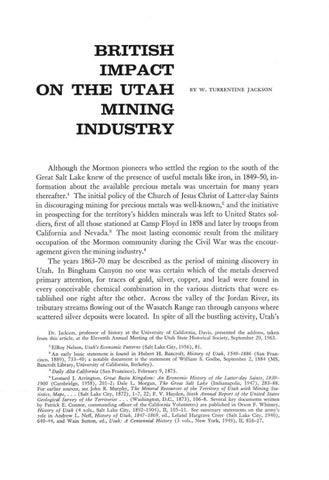BRITISH IMPACT Ol^[
^L M
j
J 1*/% T T
BY W
- TURRENTINE JACKSON
MINING INDUSTRY Although the Mormon pioneers who settled the region to the south of the Great Salt Lake knew of the presence of useful metals like iron, in 1849-50, information about the available precious metals was uncertain for many years thereafter.1 The initial policy of the Church of Jesus Christ of Latter-day Saints in discouraging mining for precious metals was well-known, 2 and the initiative in prospecting for the territory's hidden minerals was left to United States soldiers, first of all those stationed at Camp Floyd in 1858 and later by troops from California and Nevada. 3 The most lasting economic result from the military occupation of the Mormon community during the Civil War was the encouragement given the mining industry.4 The years 1863-70 may be described as the period of mining discovery in Utah. In Bingham Canyon no one was certain which of the metals deserved primary attention, for traces of gold, silver, copper, and lead were found in every conceivable chemical combination in the various districts that were established one right after the other. Across the valley of the Jordan River, its tributary streams flowing out of the Wasatch Range ran through canyons where scattered silver deposits were located. In spite of all the bustling activity, Utah's Dr. Jackson, professor of history at the University of California, Davis, presented the address, taken from this article, at the Eleventh Annual Meeting of the Utah State Historical Society, September 20, 1963. ^ l R o y Nelson, Utah's Economic Patterns (Salt Lake City, 1956), 81. 2 An early basic statement is found in Hubert H. Bancroft, History of Utah, 1540-1886 (San Francisco, 1889), 733-40; a notable document is the statement of William S. Godbe, September 2, 1884 (MS, Bancroft Library, University of California, Berkeley). 3 Daily Alta California (San Francisco), February 9, 1873. 4 Leonard J. Arrington, Great Basin Kingdom: An Economic History of the Latter-day Saints, 1830— 1900 (Cambridge, 1958), 201-2; Dale L. Morgan, The Great Salt La{e (Indianapolis, 1947), 283-88. For earlier sources, see John R. Murphy, The Mineral Resources of the Territory of Utah with Mining Statistics, Maps, . . . (Salt Lake City, 1872), 1-7, 22; F. V. Hayden, Sixth Annual Report of the United States Geological Survey of the Territories . . . (Washington, D.C., 1873), 106-8. Several key documents written by Patrick E. Connor, commanding officer of the California Volunteers) are published in Orson F. Whitney, History of Utah (4 vols., Salt Lake City, 1892-1904), II, 105-11. See summary statements on the army's role in Andrew L. Neff, History of Utah, 1847-1869, ed., Leland Hargrave Creer (Salt Lake City, 1940), 640-44, and Wain Sutton, ed., Utah: A Centennial History (3 vols., New York, 1949), II, 816-17.



